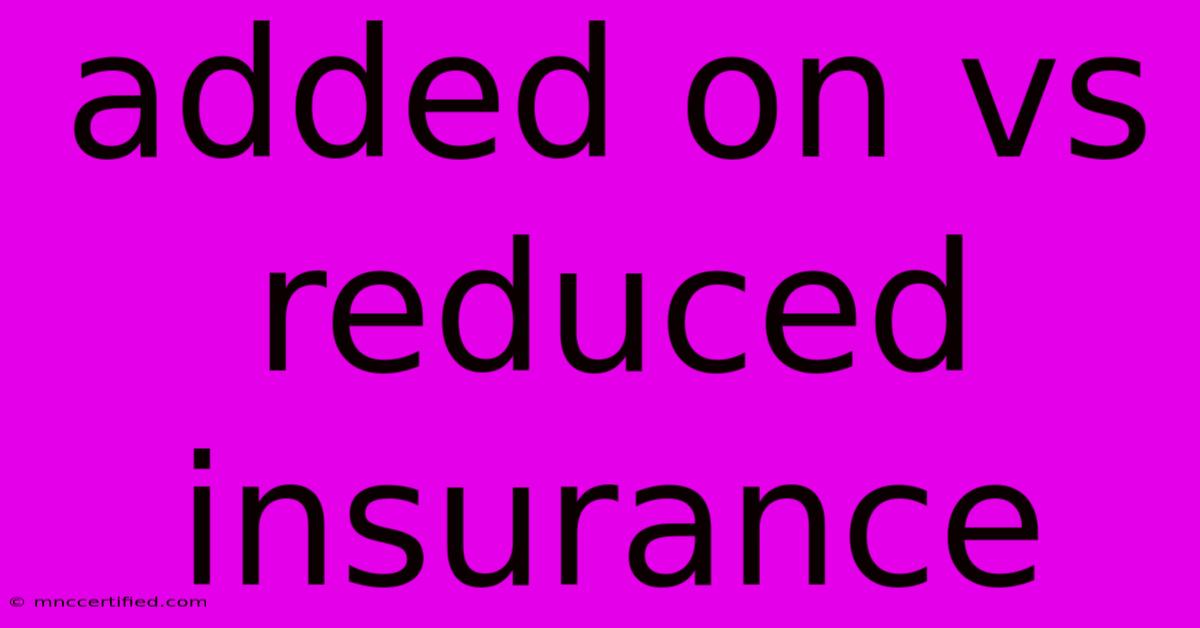Added On Vs Reduced Insurance

Table of Contents
Added-on vs. Reduced Insurance: Understanding Your Coverage Options
Choosing the right insurance can feel overwhelming. Navigating the complexities of added-on versus reduced insurance coverage is crucial for securing adequate protection without overspending. This comprehensive guide clarifies the key differences, helping you make informed decisions based on your specific needs and risk tolerance.
What is Added-on Insurance?
Added-on insurance, also known as supplemental insurance or riders, refers to additional coverage purchased on top of your existing policy. It expands the scope of protection beyond the base plan, addressing specific needs or concerns not fully covered by the primary policy. Think of it as customizing your insurance to perfectly fit your circumstances.
Common Examples of Added-on Insurance:
- Critical Illness Coverage: Pays a lump sum upon diagnosis of a serious illness, providing financial assistance for treatment and recovery.
- Accidental Death & Dismemberment (AD&D): Provides a benefit in case of accidental death or loss of limbs.
- Guaranteed Insurability Rider: Allows you to increase your coverage amount at specific life stages without further medical underwriting.
- Waiver of Premium Rider: Waives future premiums if you become disabled.
Advantages of Added-on Insurance:
- Tailored Protection: Addresses specific gaps in your existing coverage.
- Increased Financial Security: Provides extra financial protection in unforeseen circumstances.
- Flexibility: Allows you to customize your coverage to meet your changing needs.
Disadvantages of Added-on Insurance:
- Increased Premiums: Naturally, adding coverage increases your overall insurance cost.
- Potential for Overinsurance: Purchasing unnecessary added-on coverage can lead to wasted premium payments.
What is Reduced Insurance?
Reduced insurance, often encountered in contexts like car or home insurance, refers to lowering the coverage amount of an existing policy. This typically leads to lower premiums but also reduces the financial protection offered.
Reasons for Choosing Reduced Insurance:
- Lower Premiums: Reducing coverage is a straightforward way to decrease your monthly insurance payments.
- Less Coverage Needed: If your circumstances change (e.g., paying off a mortgage, owning a less valuable car), you might determine that you require less coverage.
Risks of Reduced Insurance:
- Insufficient Protection: Reducing coverage too much can leave you vulnerable in case of a significant loss.
- Higher Out-of-Pocket Expenses: In the event of a claim, you'll bear a larger share of the costs.
- Gaps in Coverage: Reduced coverage might leave significant gaps in your overall financial protection.
Added-on vs. Reduced Insurance: A Direct Comparison
| Feature | Added-on Insurance | Reduced Insurance |
|---|---|---|
| Coverage | Increases existing coverage | Decreases existing coverage |
| Premiums | Increases premiums | Decreases premiums |
| Risk | Lower risk of insufficient coverage | Higher risk of insufficient coverage |
| Flexibility | Highly flexible, tailored coverage | Less flexible, limited options |
| Best for | Addressing specific coverage gaps | Lowering costs when coverage is excessive |
Making the Right Choice: A Step-by-Step Guide
- Assess your current needs: Honestly evaluate your current risk exposure and financial situation.
- Review your existing policy: Understand the limitations and gaps in your current coverage.
- Analyze added-on options: Explore available add-ons to address identified needs. Compare premiums and benefits carefully.
- Consider reducing coverage: If you feel your existing coverage is excessive, determine if you can safely reduce it without compromising crucial protection.
- Seek professional advice: Consult with an independent insurance broker to discuss your options and obtain personalized recommendations.
Choosing between added-on and reduced insurance depends entirely on your individual circumstances. Prioritize a balanced approach that offers sufficient protection without unnecessary expenses. Remember, the goal is to find the optimal balance between coverage and cost, ensuring you're adequately protected against unforeseen events.

Thank you for visiting our website wich cover about Added On Vs Reduced Insurance. We hope the information provided has been useful to you. Feel free to contact us if you have any questions or need further assistance. See you next time and dont miss to bookmark.
Featured Posts
-
How Much Is 347 Bitcoin Worth
Nov 28, 2024
-
Ladys Crypto Price Prediction
Nov 28, 2024
-
Hezbollah Israel Ceasefire Hopeful Yet Anxious World
Nov 28, 2024
-
Fallout Trading Cards Series 2
Nov 28, 2024
-
Is Van Cleef A Good Investment
Nov 28, 2024